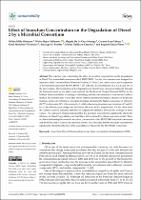| dc.contributor.author | Otiniano, Nélida Milly | |
| dc.contributor.author | Rojas-Villacorta, Walter | |
| dc.contributor.author | De La Cruz-Noriega, Magaly | |
| dc.contributor.author | Lora-Cahuas, Carmen | |
| dc.contributor.author | Mendoza-Villanueva, Karol | |
| dc.contributor.author | Benites, Santiago M. | |
| dc.contributor.author | Gallozzo-Cardenas, Moises | |
| dc.contributor.author | Rojas-Flores, Segundo | |
| dc.date.accessioned | 2023-08-01T20:04:05Z | |
| dc.date.available | 2023-08-01T20:04:05Z | |
| dc.date.issued | 2022-12-14 | |
| dc.identifier.uri | https://hdl.handle.net/20.500.13067/2523 | |
| dc.description.abstract | The objective was to determine the effect of inoculum concentration on the degradation of Diesel 2 by a microbial consortium called BIOT.PD001. For this, five systems were designed (in triplicate), which Contained Davis Minimum Medium, 5% Diesel 2 as a carbon source, and a suspension of the microbial consortium BIOT.PD001 (9 × 108 cells/mL) in concentrations of 2, 4, 6, 8, and 10% of the final volume. The monitoring of the degradation of Diesel 2 was carried out indirectly through the bacterial counts by the plate count method, the Biochemical Oxygen Demand (BOD5) by the Winkler Method modified according to Alsterberg, and the concentration of total fats by Gerber’s method. The retention time was 15 days. It was observed that the percentage of efficiency of the process increases as the concentration of inoculum increases, obtaining the highest percentage of efficiency (94.77%) when using 10% of inoculum (v/v), while when using inoculum concentrations of 2 and 4% (v/v), the efficiency percentages are the lowest, (68.4 and 66.6%, respectively). On the other hand, the variance analysis indicated that there is a significant difference between the averages of these values. The regression analysis indicated that the inoculum concentration significantly affects the efficiency of Diesel 2 degradation and that this is 86% explained by a linear regression model. There is a linear relationship between the inoculum concentration of the BIOT.PD001 microbial consortium and the BOD5 tend to decrease as a function of time. It is concluded that the inoculum concentration significantly affects the efficiency of the degradation of Diesel 2 by the BIOT.PD001 consortium. | es_PE |
| dc.format | application/pdf | es_PE |
| dc.language.iso | spa | es_PE |
| dc.publisher | MDPI | es_PE |
| dc.rights | info:eu-repo/semantics/openAccess | es_PE |
| dc.rights.uri | https://creativecommons.org/licenses/by/4.0/ | es_PE |
| dc.subject | consortium | es_PE |
| dc.subject | Diesel 2 | es_PE |
| dc.subject | bioremediation | es_PE |
| dc.subject | inoculum concentration | es_PE |
| dc.subject | biodegradation | es_PE |
| dc.subject | BOD5 | es_PE |
| dc.title | Effect of Inoculum Concentration on the Degradation of Diesel 2 by a Microbial Consortium | es_PE |
| dc.type | info:eu-repo/semantics/article | es_PE |
| dc.identifier.journal | Sustainability | es_PE |
| dc.identifier.doi | https://doi.org/10.3390/su142416750 | |
| dc.subject.ocde | https://purl.org/pe-repo/ocde/ford#2.11.04 | es_PE |
| dc.publisher.country | PE | es_PE |
| dc.relation.url | https://www.mdpi.com/2071-1050/14/24/16750 | es_PE |
| dc.source.volume | 14 | es_PE |
| dc.source.issue | 24 | es_PE |
| dc.source.beginpage | 1 | es_PE |
| dc.source.endpage | 13 | es_PE |


